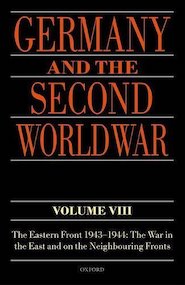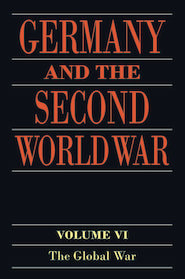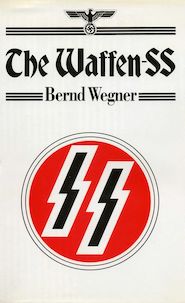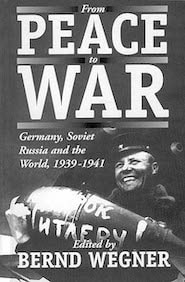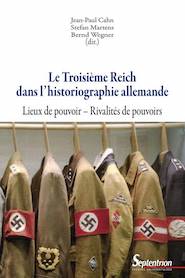International & translated publications
Please find here the international publications that have been translated into several languages.
English
Germany and the Second World War, vol. VIII
|
The Eastern Front 1943-1944: The War in the East and on the Neighbouring Fronts.
Karl-Heinz Frieser, Klaus Schmider, Klaus Schönherr, Gerhard Schreiber, Krisztián Ungváry, Bernd Wegner The latest volume in the magisterial Germany and the Second World War series, volume VIII deals with one of the most eventful phases of the Second World War: the battles on the eastern front in 1943 and 1944. In no other period of the war, apart from its concluding phase in 1945, did the Wehrmacht suffer such enormous losses. The land battles of those years, first and foremost the battle of Kursk in the summer of 1943, were among the biggest in world history. In the winter of 1943/44 the Red Army showed itself for the first time capable of conducting large-scale offensives against all German army groups simultaneously. It was no longer a matter of isolated flare-ups: the whole eastern front was in flames. The dramatic climax was reached in the summer of 1944, when the collapse of Army Group Centre led to what was then the heaviest defeat in German military history. It was nevertheless overshadowed by events on the western front, with the Allied invasion of Normandy in June 1944. And it is that which dominates perceptions in western societies to this day and has relegated the catastrophe in the east, despite its unprecedented proportions, to the rank of an almost "forgotten war." Oxford: Oxford University Press 2017, 1344 p. |
Germany and the Second World War, vol. VI
|
The Global War. Widening of the Conflict into a World War and the Shift of the Initiative 1941-1943.
Horst Boog, Werner Rahn, Reinhard Stumpf, Bernd Wegner Volume VI of the 'Germany and the Second World War' series deals with the extension of a European war into a global one in the period from 1941 to 1943. It focuses on the politics, strategy, and operations of the belligerent powers as Germany lost the initiative to the Allies, and it represents, both in content and in composition, the climax and turning points of the war. An account is given of the development of the war at sea in the Atlantic and the Mediterranean until the spring of 1943, of the changeable course of events in the North African theatre of war until the establishment of the bridgehead in Tunisia, and finally of Hitler's 'second campaign' against the Soviet Union until the stabilization of the front following the catastrophe at Stalingrad. Moreover, the United States' transition to open belligerence, after Pearl Harbor, calls for an account of the political developments leading up to that point on the Japanese and the American sides. The opening of new theatres of operations in the Pacific and over Germany, owing to the intensified strategic aerial warfare of the Allies, along with the organization of the Reich's air defences are also treated. Oxford: Clarendon Press 2001, 1301 p. |
The Waffen-SS
|
Its Ideology, Organization and Function.
Bernd Wegner This book sets out to provide a comprehensive study of the military wing of the SS, one of the central organizations of the Nazi state, from its inception to Germany's capitulation. Based upon extensive research, it attempts to provide a full picture of this controversial organization.;The author begins his account with a consideration of the political background against which the formation of the Waffen-SS is intelligible. He examines all aspects of the Waffen-SS, its organizational structure, recruitment and training, its ideology and its social ocmposition. The crucial issue of the Waffen-SS's precise political and military role in furthering the aims of the Third Reich is the central theme of this fascinating portrayal of Hitler's political soldiers. Oxford: Blackwell 1990, 428 p. Original and powerful … an exhaustively researched, tightly reasoned study that does full justice to its subject." |
From Peace to War
|
Germany, Soviet Russia and the World, 1939-1941.
Bernd Wegner (ed.) The German attack on the Soviet Union in June 1941 represents one of the major caesuras in European history. Its consequences could still be felt fifty years later. Thirty-five historians from nine different countries (including the former Soviet Union) offer a comprehensive survey of the origins, course and long-term impact of this event. The volume is not merely concerned with political and military history, but also with the experiences of ordinary soldiers and civilians. Providence/Oxford: Berghahn 1997, 632 S. |
"This collection provides a wealth of excellent research and insight. Students and specialists in the area will benefit greatly from this collaborative effort." · Canadian Journal of History
"... the greatest merit of this collection of essays is that with its help the reader can get acquainted with a great many major themes of this episode in German-Russian relations and, moreover, often see them addressed from different viewpoints and with different complementary conclusions." · H-Net Reviews (H-German)
"... an outstanding and most comprehensive work on the history and development of the Russian campaign." · Die Zeit
"... a work which marks an important direction in the study of this relationship and the war itself, which has hitherto been the subject of so much mythologising." · John Erickson, University of Edinburgh
Selected articles in English
- The Ideology of Self-Destruction. Hitler and the Choreography of Defeat.
- In: German Historical Institute London, Bulletin, Vol. XXVI, no. 2, 2004, p. 18-33. (reprinted in: Jeremy Black [Ed.], The Second World War, vol. II. Aldershot 2007, pp. 361-76).
- Facing the Global War: Germany’s Strategic Dilemma after the Failure of ‘Blitzkrieg’.
- In: Bernd Wegner (Ed.), From Peace to War – Germany, Soviet Russia and the Worlds, 1939-1941. Providence/ Oxford 1997, pp. 611-27.
- Violent Repression in the Third Reich: did it stabilize Hitler’s rule?
- In: P. T. Bushnell, V. Shlapentokh, C. K. Vanderpool, J. Sundram (Eds.), State Organized Terror. The Case of Violent Internal Repression. Boulder, San Francisco, Oxford 1991, pp. 153-167.
- The Road to Defeat: The German Campaigns in Russia, 1941-43.
- In: John Gooch (Ed.), Decisive Campaigns of the Second World War. London 1990, pp. 105-127.
- The Tottering Giant: German perceptions of Soviet military and economic strength in preparation for ‘Operation Blau’.
- In: Christopher Andrew/Jeremy Noakes (Eds.), Intelligence and International Relations 1900-1945. Exeter 1987, pp. 293-311.
- ‘My Honour is Loyalty’. The SS as a military factor in Hitler’s Germany.
- In: Wilhelm Deist (Ed.), The German Military in the Age of Total War. Leamington Spa 1985, pp. 220-39.
Français
Le Troisième Reich dans l’historiographie allemande
|
Lieux de pouvoir – Rivalités de pouvoirs.
Jean-Paul Cahn, Stefan Martens, Bernd Wegner (Hrsg.) Confrontée à un passé bien lourd, d'abord privée de sources, l'historiographie allemande s’est libérée peu à peu de la perception qu’avaient eue les contemporains des réalités du Troisième Reich. Comme toute gestion mémorielle des crises graves et des époques criminelles, l’histoire de la période 1933-1945 fut d’abord écrite en marge d’une opinion plus soucieuse de tourner la page que de se souvenir. En mettant spectaculairement en évidence la responsabilité des fonctionnaires, les grands procès des années 1960 (Eichmann, Einsatzgruppen, Auschwitz) alimentèrent la contestation par la jeune génération du passé de leurs pères. Des fictions, des polémiques relayées par les médias et des expositions spectaculaires contribuèrent à la prise de conscience. Tel fut par exemple le cas de la présentation au grand public des crimes de la Wehrmacht, qui détruisit le mythe d’une armée noble comparée à des SS responsables de tous les maux. Las d’une république en crise endémique l’électorat du Reich avait attendu des solutions miracles d’un homme providentiel. Mais selon une formule célèbre, les Allemands de 1932 n’ont voté ni pour la guerre, ni pour Auschwitz. Ils ont pourtant eu l’un et l’autre – et le nazisme en fit des instruments de son pouvoir. Quand ils en prirent conscience, il était trop tard. L’impossibilité d’agir autrement ne fut pas la seule raison de l’adhésion au régime jusque dans sa dimension criminelle. La lecture actuelle est beaucoup plus nuancée. Lille: Presses Universitaires du Septentrion, 2013, 400 S. (als Mit-Hrsg.). |
Articles choisis en Français
- Pourquoi une guerre à l’Ouest en 1940? Quelques remarques sur la grande stratégie d’Hitler. In: Stefan Martens, Steffen Prauser (édit.), La guerre de 1940. Se battre, subir, se souvenir. Vielleneuve d’Ascq (France) 2014, p. 19-35.
- Les élites militaires à lépoque du national-socialisme. In: Corine Defrance, Francoise Knopper, Anne-Marie Saint-Gille (édit.), Pouvoir civil, pouvoir militaire en Allemagne. Villeneuve d’Ascq (France) 2013, p. 75-93.
- La «terre brûlée»: remarques relatives à un aspect délaissé de la politique allemande d’anéantissement menée à l’Est en 1943/1944. In: Fréderic Rousseau & Burghart Schmidt (dir.), Les Dérapages de la Guerre du XVIème siècle à nos jours – Kriegsverbrechen vom 16. Jahrhundert bis zur Gegenwart. Hamburg 2009, p. 200-208.
- Hitler, chorégraphe de l’effondrement du Reich. In: Vingtième Siècle. Revue d’Histoire, 92 (oct.-déc. 2006), p. 67-79.
